As you know, I've been working hard to put together a post about stamping tips for you for a couple of weeks now. This has turned out to be more of an undertaking than I initially thought it would be, so I hope you'll forgive me for the delay! This is going to be a LONG post, but after trying to divide it up, I think having it all in one post is the best way.
I'm going to start off with a with a brief overview of the basic steps of stamping, and then go into detail about some tips and tricks for each step. Then I'll answer some questions you submitted to me about particular issues you struggle with, if they haven't already been covered. Please keep in mind that there isn't just one right way to do things! What I'll write here is what works for me, or what I've been told by other people who love to stamp. And if you have another way that works for you, I'd love to hear about it, so please share it with me and my readers! And if my way doesn't work, vary it a bit before giving up. :)
One final word that covers everything I'm going to say...Practice makes perfect. This is cliche and nobody wants to hear it, but it's absolutely true. When I first began stamping, I spent several sessions (5-6) just playing around with the stamps and stamping--I'd paint my nails all a good base color, usually white or something dark, and I'd stamp. Then I'd remove the stamping with a swipe of remover, and stamp again. When the swiping took off too much polish, I'd repaint. And then while it was drying, I'd practice with fake nails. And while I've never done this myself, another great way to practice is by using the semi-flattened marbles you can get at craft stores (I saw this tip first in a video by Ginasoguesswhat on YouTube). I guarantee you that no tip I can give will completely remove the need to practice, but hopefully I can help cut down the learning curve for you. :)
Okay, so let's have at it!!
For orientation purposes, nail stamping involves the following 4 main steps:
1) Put the nail polish onto your nail plate.
2) Scrape the nail polish off of your nail plate.
3) Pick up the image from your plate with your stamper.
4) Place the image onto your nail with your stamper.
Sounds easy, doesn't it? But as you know, many things can go wrong along the way...::cue dramatic music::...
Step 1) Put your nail polish onto your nail plate.
There are two important components here, picking the right polish and putting the correct amount on the plate. Picking the right polish can be tricky, because very few polishes look good over all other polishes (except maybe Konad black and white and similar blacks and whites).
- One way to get a first guess about whether a polish will be opaque enough to stamp with is to look at it on the brush. If you can't see the brush through the polish, it's a good candidate to stamp well.
- Test your polish before stamping. You can do this on a sheet of paper, a piece tape, a real or false nail, or flattened marble (see above--you can get these for about $1 a bag at craft or floral stores). First paint your base paint, wait for it to dry, and then try stamping over it with your target polish.
- Inky Whiskers constantly tests out different polishes over black and white; check out her blog for tons of polish tests.
- Metallic and foil polishes as a general rule stamp well.
- I have great luck stamping with China Glaze cremes.
- Sally Hansen Insta-Dry polishes are almost all wonderful for stamping.
- Pure Ice metallics and cremes are generally good for stamping.
- Most strongly linear holos (Nfu-Oh, for example) stamp very well.
Putting the correct amount of polish on your plate is also important, but is fairly forgiving. If you put on too much, you can always scrape it off by scraping twice or scraping more firmly; but of course you want to avoid this if you can, and practice will help here. As you're learning, the main issue is you don't want to put on too little polish, or it won't cover your whole image.
- Err on the side of too much rather than too little polish. If you use too little polish you'll either get a patchy image or your image won't pick up. One of the tricks experienced stampers use to save polish is to only put polish on half of the image, and then scrape that polish over the rest of the image. This is a great tip, but if you're just starting out or having problems getting a good image, don't do this--wait until you get a bit more comfortable with stamping. Figure 3 below shows an image with bald spots because it didn't have enough polish.
- Here is what your plate should look like with the proper amount of polish (see figure 1). Notice that it's fully covered, but you can still see the indentations; if you have so much glopped on that you can't see them anymore, you probably have too much:
 |
| Figure 1. Notice that the image is fully covered, but you can still see the indentations of the image. |
- How fast should I move during this step? You have a fair amount of lee-way here. Your polish is going to dry more slowly until you scrape it, so you have a few extra seconds here. Not enough to go make a cup of tea or anything, but a bit more time. :)
Step 2) Scrape off the nail polish from your plate.
This is where things start getting a bit trickier. Lots of things can go wrong here, and you might not even realize it until later on in the process. What I mean by this is, if you're having problems picking up your image onto your stamper, most likely it's because you did something wrong here.
In theory, you've put your polish onto your plate, and now you're using a scraper to remove the polish from the plate. Let's talk about issues that crop up here:
- What sort of scraper should I use? This is largely a matter of personal preference, and the answer is, use whatever works for you. Try a metal scraper, a plastic scraper like a credit card, a paper scraper like an index card. If it works, don't question it! My own personal preference is a metal scraper. I feel like I get the most even control with a metal scraper; I don't get any gaps between the surfaces, and I can 'feel' when it's scraping effectively and when it isn't. But doesn't it scrape up your metal plates? No, not in the important sense. The plates don't look pristine and new, it's true. But it doesn't damage them or make them less effective in any way. And I bought the plates to use them, not to display them looking pretty, so it doesn't bother me if they get cosmetically scraped. If you feel differently, of course, definitely try out other scrapers! But if you find nothing else is giving you a clean image, you might want to rethink that metal scraper. :)
- How hard should I scrape? You should scrape fairly hard; too light tends to leave too much polish, and it's hard to scrape *too* hard (but yes, it can be done, lol). That said, it depends on the person and the plate. I've had some plates where I had to use a lighter hand to get a good image. If you're having a hard time picking up your image, it's possible you scraped too hard or too gently. If too hard, you'll get no image or only bits of the image. If too gently, you'll just get a blob of polish. This is part of where the practice comes in; try it, and adjust the pressure you're using as needed. Most importantly, you want to make sure you're applying even pressure to the whole image.
- Angle matters. As strange as it seems, I've found that the angle I scrape at makes a big difference, because it has a big impact on my control. Generally speaking, I find that about a 45 degree angle works for me (see figure 2). If I'm too up-and-down or too flat, my scraping is uneven and I get big missed spots (or lines) of polish.
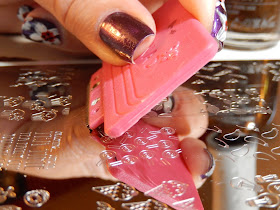 |
| Figure 2. This 45 degree angle is what I favor for my scraping. It gives me good control and good contact with the plate. |
- Can I scrape twice? Yes, you can, but be careful. If you scrape twice, you're taking off more polish and taking more time, and both will make your image dry faster. So if you have a big blob and scrape a second time, just make sure you pick up the image fairly quickly afterward. I will often scrape twice if I've missed an area.
- Don't worry too much about small lines. Believe it or not, in most cases, if you have small lines from scraping when you pick up your image, they won't even show up. Bigger lines or splotches will show up, however (see figure 3 and caption below).
- How fast should I move during this step? Pretty fast. If you take too long, and scrape too much, the polish will dry and it won't pick up. Now, I'm not saying you have to do your impression of The Flash--you don't have to go so fast that you're just a blur to the people around you or anything, and you don't need to go so fast that you get flustered--but you should be picking up your image pretty much right after you scrape. Scrape, wipe off scraper, pick up stamper, pick up image. Normal movements, but no big pauses in between.
- Here is what your image should look like when improperly (figure 3.) and properly (figure 4) scraped:
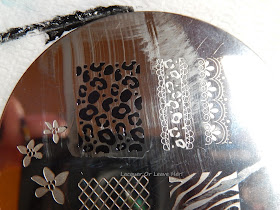.JPG) |
| Figure 4. Properly scraped image. |
Step 3) Pick up the image from your plate with your stamper.
For this step, you place your stamper on the plate, and pick up the image. You can do this by coming directly down on to the image (figure 5), or by rolling your stamper over it (figure 6).
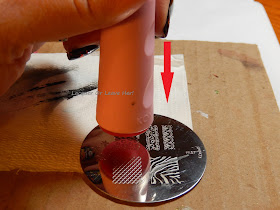 |
| Figure 5. The direct-pressure-down method of picking up your image |
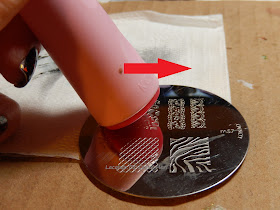 |
| Figure 6. The roll-over-the image method of picking up your image |
I prefer the direct-pressure-down method shown in figure 5. I've never been able to get good results by rolling over the image--it just gooshes and squooshes and I get a really bad image. So I personally strongly recommend the first method over the second.
- Should I file my stamper? I have never found this to be necessary. I have 5 stampers of different types, and I've never needed to file any of them; I know many other people that haven't had to file theirs, either. Of course, plenty of people swear by this, so if you want to do it, do it! But if you're asking my opinion, I don't see any reason for it. If you suspect your stamper has residue on it, try swiping it with acetone or rubbing it with an eraser, and that should be enough.
- How much pressure should I use? You need to use a medium pressure. If you push too lightly, if won't pick up or won't pick up evenly. If you push too hard, you are gonna get smoosh and distortion. If you're not getting an image you like, and you're applying and scraping so your images look like the steps above, try varying the pressure you're using until you get a result you like. Figures 7, 8, and 9 show good and bad images:
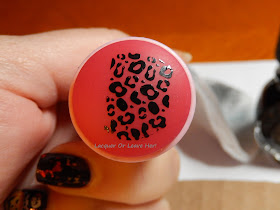 |
| Figure 7. Good image! |
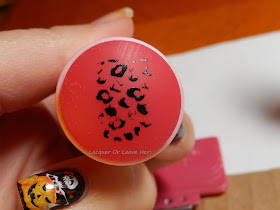 |
| Figure 8. Bad, bad image! This either had too little polish, wasn't picked up fast enough, or had too little pressure on the stamper when picked up. |
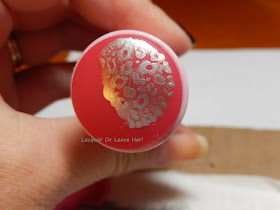 |
| Figure 9. Bad, bad image! This either had too much polish, wasn't scraped with enough pressure, or had too much pressure on it when picked up. |
- Will I get better results if I use an XL 'squishy' stamper rather than a regular stamper? In my opinion, I think you should be able to do any basic stamping with a regular stamper with a little practice. I don't believe that the squishy stampers are easier to use--they are just better for certain things; squishy stampers are better for picking up really large images, and are better for dealing with certain types of alignment issues (I'll talk more about this in the next section). However! If a squishy stamper works better for you, then use it! More power to ya!! Just don't rush out to buy a squishy stamper thinking it will solve your stamping problems, because it probably won't. You can have all of the same problems we've talked about already if you aren't applying, scraping, and picking up correctly, whether it's a squishy stamper or not.
- How fast should I move during this step? You're gonna want to move pretty fast here. Once the polish is scraped, it's thin, and will dry quickly. So don't let it sit too long, or you'll get something that looks like figure 8, or worse, doesn't pick up at all.
- Make sure to check your image before moving on to the next step. If you don't have a solid, smooth image to start with, you aren't going to get good image transfer. It's much easier to wipe this off and start again than to put a bad image on your nail.
Step 4) Place the image onto your nail with your stamper.
Oh boy, now we're into the big issues. This is where things get trickiest of all, because you're trying to put your image right where you want it, but you don't have all day to do it. It's easy to get flustered because you're worried that your polish will dry, and then move too quickly and mess everything up. And nobody wants to have to start all over again!
- Resign yourself to the fact that sometimes you're going to have to start all over again. The most experienced stampers, who have tons of tricks they use and tons of manicures under their belts, sometimes have to start over, and so will you. Hopefully it will happen less and less with the more experience you get.
- Always put on topcoat between your base polish and your stamping. If you make a mistake and you have topcoat on, you can sometimes swipe your stamp off with polish remover or acetone without damaging your base. If you don't have topcoat on, you'll be starting over.
- Straight-down vs. Rolling-over methods: There are two ways you can transfer your image from your stamper, just like there were two ways to pick it up. You can either push the stamper straight down onto the nail, or roll it over the nail. In this case, I vastly prefer the rolling-over method, largely because I have very curved nails. If I try to stamp straight down onto my nail with a full-nail image, I'll get a janky stripe down the middle and nothing else! So, I start on one side of my nail and roll across to the other (see figures 10-12 to see what I mean). This should work no matter how flat or curvy your nails are. If you use the rolling method do not use a pushing motion; roll the stamper, don't push it into the nail. Gentle pressure works best here.
- How fast do I need to work with this step? You have a little more time here than you did with your previous step, and can take a few extra seconds to get things lined up the way you want them to. But, if you wait too long, your image will dry out and either won't transfer at all, or will only partially transfer. If that happens, swipe off (you had topcoat on, right?) and try again. 'Cause if you don't get it lined up right you're going to have to start over again anyway, right?
My method for transferring my image and aligning where I want the image to be:
A) I start with the stamper placed on one side of the nail, and push the stamper right up to the edge of the nail; I line it up with the edge of the image if it is a full-nail image. Working with a full-nail image is the easiest alignment to execute--just make sure that you have your stamp initially positioned so as you roll it over, it covers the whole nail from top to bottom. Note in figures 10-12 how I have both the top (near my nail bed) and the bottom (near my nail tip) positioned so I can see that there is enough stamper to cover my whole nail (if it had a full-nail image on it). Once I see that is safely the case, I can begin rolling.
B) If I'm trying to line up a smaller image, I line up the edge of the image with the location on the nail where I want the image to be. To demonstrate this, I show in the picture how I'm lining up an image of a coffee pot with an image I've previously stamped (and filled in) of that same coffee pot; I'm using the silver coffee pot as my 'anchor' for where I want to place my image. Looking at myy fingers, my eyes would be right where yours are now; I do this right up in front of my face. You can see over the three pictures how I bring the image closer and closer to the anchor point, pressing my nail into the bare part of the stamper as needed, until I am fairly sure it's going to match up. Then, I roll it over:
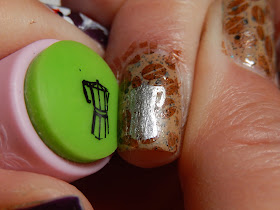 |
| Figure 10. Demonstration of rolling. |
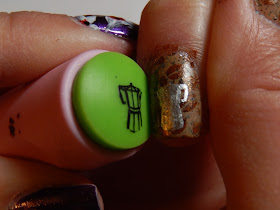.JPG) |
| Figure 11. Demonstration of rolling, part 2. |
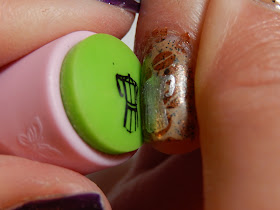.JPG) |
| Figure 12. Demonstration of rolling part 3, and demonstration of aligning. |
C) Now that you're all lined up, roll your image over your nail. Use a gentle, even pressure as you roll--this is very important. If you stutter or hesitate or try to adjust the stamper while you're rolling, you'll get smudged or misaligned parts of your stamp. If you push instead of roll, you will smudge--the polish only needs to come in contact with the nail to adhere, it doesn't need to be steam-rolled. :) Also, when you reach the end of the nail, do not lift off! Keep your rolling motion going until the stamp is all the way off the nail (even keep it rolling over part of the finger rather than lift it up). If you lift off too soon, you can get part of your image that lifts back off of the nail or that doubles back on itself on the nail. Once you see the stamper has rolled completely off of the nail (see figure 13), you can lift it off your finger:
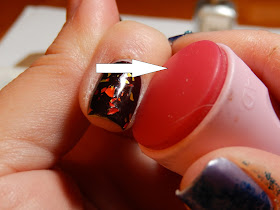 |
| Figure 13. Your stamper should be completely rolled off of your nail before you lift it up. |
D) This method works well except in one case...if you want stripes (or something similar) down the length of your nail. Then, it can be easy to get a small warp that wouldn't normally show up on another design, but makes your stripes look really messed up. In this case, you want to use the same roll method, but from the top to the bottom of the nail, rather than from side to side (see figure 14 below). You do want to spot-check that the line of your stamp is pointed in the right direction after you've placed your stamp near your cuticle, then roll away!:
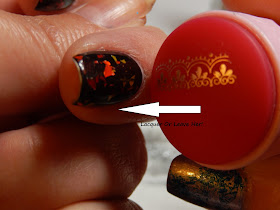 |
| Figure 14. How to vertically align your stamped image. |
- Doesn't this take too long to get good image transfer? When you're first trying to get it down, now and then you may find that by the time you go to transfer your image, it has dried out and doesn't transfer, but this shouldn't happen often, especially after your first couple of tries with it.
- What about French tip images? Ugh. These are tough, but they can be done. Remember above I said that squishy stampers are better for some types of stamp alignment? This is one of them. With a squishy stamper, you can get your image onto your stamper, and then push your nail directly down into it wherever you want. Because it is squishy, it will collapse around your nail and put the image directly where you're pushing into it. I talk more about this in a video I made about using the squishy stamper, but if you want me to take pictures of this, let me know. :)
Reader Questions!
I think I've covered the basics above...so now I'm going to turn to the specific reader questions I got.
Q: One question I got (not sure if this person wants to be anonymous) was about overlap stamping on longer nails. For people with longer nails, the Konad image isn't long enough to cover from cuticle to nail tip, and in theory, it should be possible to stamp the image twice, lining it up in the process.
A: In theory, this is possible. In practice, it's pretty darn hard. The best tips I have for aligning the two stamps would be the ones I shared above; these should get you pretty close to having a well-aligned image, although even people who are pros at this don't get it 100% perfect. So, I have two other suggestions for you. The first is, choose images that are forgiving when it comes to overlap; either very busy images like leopard prints where it doesn't matter if things are lined up well, or more open images that have plenty of room to look fluid if not stamped perfectly. You can see an example of this by clicking here.
But personally, I think the best choice is to use plates that have larger images; there are a lot of these now, and you don't have to fuss with those alignment issues. You can see one of these plates in the same video I linked above, and I have several others on my YouTube channel as well. Another brand that I think has larger images is Dashica, but I don't own any of those (yet!) so I can't say for sure. If you do use one of these larger image plate, be sure to get yourself an XL stamper, otherwise you're not going to be able to get the whole image, and then what's the point!
Q: Nathalie asks about problems getting her image to transfer: "I can't pick up the full image, or when I do it doesn't transfer to the nail...I also used the squishy stamper for the first time, and couldn't position it right. It came out with the image half-transferred and the rest was just a trace of the image."
A: If you're having a hard time picking up the image, this is usually because your polish dried out before you picked it up, either because you took too long or you scraped too hard or too many times. If it's not transferring to the nail off of the stamper, first make sure you got a good image--if you did, and it's not transferring, you probably took too long from the time you put it onto the stamper to the time you tried to get it on the nail. If you don't have a good image, check the pictures of bad images above and see if those help figure out your problem. As for the squishy stamper, you can have all of the same issues with that type, too, and if it half-transferred, I think you're having the same basic issue (taking too long or scraping too hard). With respect to the positioning issue, let me know if what I wrote about aligning your image helps solve the problem. If none of this works, let me know and I'll see if I can help you troubleshoot from there. :)
Q: Rach asked: I sometimes smudge the picture when stamping...what am I doing wrong? Pressing too hard?
A: That's one possibility. Another is if rather than rolling your image onto your nail, you're doing more of a pushing motion onto the nail. Either way, try to be gentler and that will probably help. Also, you are probably doing this, but check your image before you transfer it to make sure the smudging didn't happen when you picked the image up. :)
Q: Hooked On Varnish asked: I'd like tips on getting placement right, especially with the French tip and full nail images!
A: Did my tips above help? If not, let me know what happens when you try to stamp and I'll see if I can add something more. :)
Q: Lisa N asked: How do you get the stamping design placed on your nails perfectly? I always struggle with getting the whole image transferred on my nails.
A: Did the tips above help out at all? Usually the rolling method should help you get the whole image across your nail, especially if you make sure you have it aligned correctly before you start your roll. But if not, let me know what's going wrong in the comments, and I'll try to help further. :)
Q: Manis By Moore asked: I struggle with double-stamping. Like picking good images to stamp over other and stuff like that. Maybe also some tips for when the whole image doesn't transfer. Ideas to fix it without redoing the whole image.
A: Okay, let me start with ideas for fixing a problem if you don't want to start over. Of course you can always try to stamp the image again, matching it up to the part that stamped correctly. That's actually not a bad thing to try if only a small part of the image went wrong, and I often do that myself. If one little bit didn't transfer and is still on the stamper, I'll just line it up and try again; or I'll restamp just that area and try again. Even if it doesn't come out perfectly, if it's a small area, you often can't tell.
Another fix is to do something else over the boo-boo. Some of the most amazing manis start out as a mess-up that someone tried to fix! For example, you could use the saran-wrap technique to put color around the edges of your nails and cover any bald spots, but still have it look random. You could do the same thing with bits of nail foil. You could find another solid stamp and stamp over your bald spot, and then incorporate that stamp onto your other nails, like you meant to do it the whole time. If only half of your nail got stamped and the other half didn't, you can turn it into a color-blocked mani by taping off and painting one half of your nail on each nail (or just on an accent nail). Great creative! There have been plenty of times when a well-placed rhinestone or stud has hidden a slip or a splotch here and there on my manis, lol.
You also asked about double-stamping. Funny how this is much harder than it seems like it should be, isn't it? The simple answer is that it's always a good idea to test out your combinations on a sheet of paper or tape before you ruin a full base mani. But, I've noticed a few rules of thumb that help me here (this still isn't my strongest area!). The polish you choose for your top layer of stamping should be very opaque, and the stamp you choose should be solid, for best results. If you try to stamp a white flower over black stripes, you're probably going to be able to see the stripes through the flower, but if you stamp a dark flower over light lines, you'll probably be okay. Also, the most effective manis I've done of this kind have less of a contrast between my base coat and my first layer of stamping, and more of a contrast between my top layer of stamping. So, for example, I might choose a medium blue base, a light blue stripe background stamp, and a dark purple flower to stamp over it. Finally, you don't want your second layer of stamping to disappear into your first layer. Vary the sizes to make sure your second stamp doesn't visually get lost in your first. :)
Q: Cin O. asked: I have the hardest time with scraping. I always seem to miss a part or it leaves a trail or line. Timing is a huge issue for me with polish drying before I get it scraped, etc...I also have trouble with 'seeing' how the image should be laid on and get a lot of my designs backwards of how I want them.
A: With respect to the scraping, I hope what I mentioned before helps a bit. As for timing, that should come with a little bit of practice...once you get used to how to scrape confidently, etc., it will take less and less time. In terms of 'seeing' how the image should be laid out, I hope that my positioning tips above help with this? Let me know if these don't help, and we'll troubleshoot. :)
A: With respect to the scraping, I hope what I mentioned before helps a bit. As for timing, that should come with a little bit of practice...once you get used to how to scrape confidently, etc., it will take less and less time. In terms of 'seeing' how the image should be laid out, I hope that my positioning tips above help with this? Let me know if these don't help, and we'll troubleshoot. :)
Q: Miss Intensity Nails asked: I find alignment to be a big issue for me? How do you get every finger to look the same!? Also, my designs fold over on its own while transferring on the nail creating a blob. Almost as if the design is sticking to the stamper then finally releases like a stretched rubber band.
[NOTE: I am going to do a follow-up tutorial to illustrate this answer.]To get every finger to look the same, try using the alignment method above, and add in this. Let's say you're using a full-nail image. Look on the edge of the image and pick a flower (or whatever) that you want to be on the center of the edge of your nail. Line it up. Then, for the next nail, use that same anchor point to line up your stamper. Same for the rest of the nails. Now let's say you want to put just one flower at the center of each of your nails. Try putting a teeeeeeny dot of the polish you're using to stamp with right at the center of each nail, and then use that to line up your stamp. Even if it's not 100% perfect, I bet you won't be able to tell much difference. And before you know it, you'll know your nails well enough to know where center is when you align it without that help. :)
[NOTE: I am going to do a follow-up tutorial to illustrate this answer.]To get every finger to look the same, try using the alignment method above, and add in this. Let's say you're using a full-nail image. Look on the edge of the image and pick a flower (or whatever) that you want to be on the center of the edge of your nail. Line it up. Then, for the next nail, use that same anchor point to line up your stamper. Same for the rest of the nails. Now let's say you want to put just one flower at the center of each of your nails. Try putting a teeeeeeny dot of the polish you're using to stamp with right at the center of each nail, and then use that to line up your stamp. Even if it's not 100% perfect, I bet you won't be able to tell much difference. And before you know it, you'll know your nails well enough to know where center is when you align it without that help. :)
The folding design is probably due to uneven pressure when you're stamping, or lifting off too soon. Try to make sure you're using a very even, gentle pressure when rolling your image. If that's too light, try again with a little more pressure, and a little more as needed. :)
Q: Nunya Beezwax asks about a kit she bought that doesn't work well, and results in an image that's either a blob, or only part of a transferred image, or gets no transfer at all.
A: Try the tips I talk about above for scraping and stamping, I think those will probably solve your problem. If that doesn't work, try a different (but reputable!) inexpensive set, and see how that works. I have one of those TV kits and it works fine, but that's because I didn't start with it--I was an experienced stamper by the time I got it, and could adjust my scraping/stamping to it. If it continues to give you trouble, it may just be that the quality is too poor in the set you got (sometimes plates from even highly reputable brands are defective and have to be returned). Try buying a reputable scraper/stamper and a single reputable plate or reputable set, and see how that goes. You can get the XL Cheeky plates for around $10, and can get scraper/stamper sets for about $5 now, both on Amazon. But, you might as well play with the one you have again, and see if you can get it to work!
Wow, that was a lot of writing!! Let me know if there are things that don't make sense, or things you'd like more clarity on. I know this is fairly bare-bones, so feel free to ask away so I can clarify or expand on different areas according to your needs. I have already written way too much for one post, so I'd rather follow your lead on what more you'd like to know! And if anyone has any other tips, please do let me know! I don't claim to know anything but the tip of the iceberg when it comes to stamping expertise. :)
Thanks for stopping by, particularly if you made it all the way through! Please excuse any typos, I don't think I'm going to be able to do a final proof until tomorrow, lol. :)
Hugs and stamping love,
M.
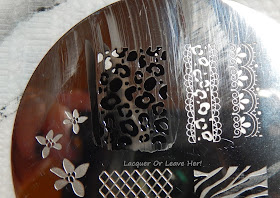
Extensive, thoughtful post! Lots of great tips and questions answered. Thank you!
ReplyDeleteI'm very glad it was helpful! :)
DeleteAwesome post!!! Great information and very helpful!!
ReplyDeleteThank you so much! I hope it answered your question okay. :)
DeleteLots of great tips, you have done a marvelous job here. A question.. The skeleton and pumpkin design on your nail? when, where, what?
ReplyDeleteHee hee hee...it's a decal for a review I'm working on for BPS. I'll be showing it soon. :) And thank you!
DeleteWow amazing post explaining stamping! I've just started to get into so this was extremely helpful to read. Thanks Michelle! :)
ReplyDeleteYou're very welcome! I hope it helped with your question a bit. :)
DeleteBrilliant! Bravo! Well done, Dahling!!!
ReplyDeleteI've found stamping on DIY Decals to be a wee bit easier than stamping directly on my nails:
1) It's much easier to stamp on a flat surface than a curved nail.
2) I can have nail art on both hands.
As a bonus, decals can be colored in for more nail art options
P.S. Thanks for da plug! <3
Thank you! Those are great points about decals, for sure--I also love that method, but never thought about how good it would be for people who struggle with regular stamping. :) And thank YOU for all that testing you do!
DeleteNo prob...everybody needs a hobby! lol
DeleteDat's right!! <3
DeleteAmazing!! Some very clever & useful tips there! And some awesome nailart, too (loooveee the coffee-themed one!)
ReplyDeleteHee hee hee...I tried not to completely give away the full look--I'll be showing it to you before too long. It was just the perfect time to take those pictures about alignment. :)
DeleteThank you so much for this post! I had a bad stamping day yesterday, and you have just answered my beginner questions! :)
ReplyDeleteOh noes! Bad stamping days should be forbidden by law! The worst is when you're doing something simple that you've done before no problem but for some reason everything goes wrong. Arghhh!! (and you're welcome!)
DeleteYou are very welcome! :)
ReplyDeleteThanks for all of the useful information. Are we allowed to pin this? I have a 'how to' board & it's helpful to have everything in one place.
ReplyDeleteYes please do! I have no idea how to pin a whole page or I would do it myself. Instructions please!
DeleteAs long as you pin from this page, any picture you choose will lead back here when clicked from Pinterest.
DeleteHere's what I pinned:
http://pinterest.com/pin/56013589088797337/
Oh & thanks :)
DeleteOh, I see. I thought you knew a way to pin a whole page and I was going to have to go on a pinning spree, lol! And no problem at all, I'm just excited you wanted to pin it!
DeleteExcellent tutorial! Going to share this :)
ReplyDeleteThank you thank you! Glad you liked it. :)
DeleteI have taught myself most nail art techniques and this one ( stamping) has made me nuts. I have the most problem with scraping. I can't seem to get it right. I even learned water marbling quicker than stamping! Please please make a tutorial! And thank you Sooooo much for this informative blog. Its helped me, but I don't know if it will improve my outcome.
ReplyDeleteWatermarblng is my Waterloo!!!! :P
DeleteOkay, tell me what happens when you scrape--what are the results you're getting that you don't like? Then I'll try to diagnose. :)
Also tell me what you're using (polish, type of scraper, type of plate). :)
DeleteThank you for this excellent post!
ReplyDeleteI am much more comfortable with stamping after months of practice, but I'm not perfect. It's good to see I;m basically doing everything right, but I'l take those alignment tips and see if it makes a difference!
Thanks so much! Let me know how it goes. :)
DeleteExcellent post! Only thing I would add is if you are having problems with picking up the image is to check if you removed the plastic film on the stamping plate. I learned that the hard way. Twice.
ReplyDeleteROFLMAO! I've soooo done that, lol!
DeleteThanks for all this info! I can never get enough stamping tips~ Also, thanks for answering my question, will definitely be trying out your techniques soon :D
ReplyDeleteYou're very welcome! Let me know how it goes, and I'm always happy to answer specific questions--I actually prefer it because otherwise I'm sort of shooting in the dark hoping I'm giving information that's useful! So thank YOU for your question. :)
DeleteThanks so much for your tutorial. When I started stamping I read how everyone said not to use the metal scraper because it'd scratch your plates. After struggling to pick up smaller images I came across your tutorial. I tried my metal scraper and it was so much easier! So my plates don't look as shiny and brand new, but what's the point if I can't use them? I found all your tips very useful, thanks!
ReplyDeleteYes, yes, yes, that's exactly how I feel! If others can use them just as easily with other scrapers and keep them pristine, great. But I can't--my metal scraper is light years easier to use, and I'm really okay with not having perfect plates, because I didn't buy them so they could look perfect, lol. Thanks so much for your feedback! :)
DeleteThank you so much! Stamping has been driving me crazy. The first time I tried it, it worked fine, but since then I haven't been able to get it to work at all! I've bought multiple stampers, plates, specific Konad stamping polish, and none of it is working, so it's obviously my technique that is failing. After reading your very detailed tutorial, I think my scraping is the issue. After I scrape, no matter how much polish I glob onto the image initially, there is almost none left on the plate at all - somehow, I am scraping the polish right out of the indentations of the image. I think I was too focused on not leaving "scrape lines" of polish, so I would scrape too hard, or too many times (twice, usually). I'm going to try again tonight and hopefully be successful.
ReplyDeleteYou are very welcome! Let me know how it goes--if you're still having problems maybe I can help. :)
DeleteThank you so much for all the hard work that obviously went into this tutorial! I've been wanting to stamp for over a year now, but when my kit came in the mail (one of those as seen on TV kits) it was such a dismal failure I kind of gave up and only pulled out a couple more times after that. You have inspired me to dust that stuff off and try again now that I'm armed with all these tips and tricks :0)
ReplyDeleteI'm so glad it was helpful! One more thing, though. The TV kits are not always the best quality, so if you try it again and are still frustrated, drop me a line and I'll give you some recommendations for stuff to start with. :)
Deletethank you for posting.I love your blog
ReplyDeleteThank to your sharing about your experience how to apply a nail polish.
ReplyDeleteI'm glad you found it helpful. :)
DeleteThis is such a wonderful post that I have bookmarked it! Thank you! I have stayed away from stamping, but now I think that I might try it...just need to choose the best tools!
ReplyDeleteThank you, I'm so glad it was useful! If you have any questions or anything you'd like me to post about, let me know. :)
DeleteI am preparing myself to start stamping. This is the most thoughtful, detailed stamping tutorial I've come across. Thank you so much!!
ReplyDeleteThank you so much--that really makes my day, I can't even tell you. I'm so glad it's useful! <3
DeleteThank you so much for the post... I have made progress! Yay!
ReplyDeleteI am you salon express (as seen on tv kit). Previously, I wasn't making any transfer but now I can make transfers. But the transfers are extremely light that I can hardly see them. After reading your post I found out I wasn't making transfers because I was scrapping wrong. I wasn't maintaing a 45 degree angle. Now, I am making transfers after refining my scrapping technique but its still very light. What could be wrong? Can you tell me the direction of scrapping and should the scrapper be inclined towards me or away from me? I use a plastic debit card for scrapping. DO you think its the kit itself that's wrong or maybe my polish? I am using random polishes. I may have to buy the polishes you listed but not before I know I am doing everything right. Thanks for the time!!!
Yay! We're figuring it out, lol. :)
DeleteIf your image is intact, but it's transferring light so you can barely see it--I'd bet dollars to donuts the problem is your stamping polish. If you're in the US, grab yourself a Pure Ice Silver Mercedes (I think it's called Silver Star now)--it's $1.99 and will stamp beautifully on *anything*. If you're not in the US, grab a Barry M Silver Foil or Gold Foil, or a Konad black/white.
I normally scrape away from myself (and the scraper is angled away from me), that gives me the most control. Try that, but if that doesn't work for you, vary your angle til you find what does.
I personally have really struggled with using a debit/credit card for scraping, it just does not work well for me. I always suggest that people new to stamping start out with quality tools--that means a quality stamper, scraper, polish, and plate. I firmly believe that the right equipment is essential at the start.
On that note, I have the salon express kit, and it's the hardest set of plates I have to work with.
So to sum up...Buy a better polish first, then try a metal scraper, and if that doesn't work try a different set of plates. :)
Thanks a ton for the reply. I will be trying all of the tips you suggested. I am in the US and I should be able to grab Pure Ice from my local walmart. Btw, I have become fan of your blog and you are a stamping queen. I will let you know when I succeed. Thanks again! :)
DeleteThank you so much!!! You made my day!! :)
DeleteVery helpful post! Thank you! I am shopping for the " perfect " stamper...if there IS such a thing? I have used my daughters squishy one that comes with the CiCi & SiSi kits...and while I get good success from it, and I can surely borrow it anytime I wish, I want my OWN!...LOL! I purchased a double sided one from BPS store ( black and the stamping part is white on one side, and a smaller red one on the other ) and it comes with a small bell shaped plastic scraper, and a larger plastic scraper...do you know which one I'm speaking of? I am NOT having success with this scraper at ALL! I have tried and tried...but the images just don't stick to the WHITE side. I can get it to work on the red side, but it's SO tiny! This brings me to wanting a new, more reliable stamper! I seem to see the Konad over and over when I look at various blogs. Do you think I'm safe with ordering this one? I have VERY small nails, and they are a bit curvy if that has ANY bearing in your decision. Thanks so much for your help!
ReplyDeleteMy fast answer is, I think the Konad pink stamper is the 'perfect' stamper, or as perfect as it gets. My more complete answer is I think different stampers are good for different things, and the squishy stamper you're talking about (I do know it, I have the same one!) is really good for certain types of stamping (like stamping stripes and French tips). I have heard, although I have never had to do this, that if you can't get anything to stick, try going over it lightly with an emery board. Just be very careful and start lightly! Anyway, yes, I'd say Konad is a safe bet. :)
DeleteThanks for this post, I am completely knew to this and wasn't sure how to go about doing this whole stamping nails. I've done card-crafting where I stamp cards so it should be semi-similar, right???
ReplyDeleteGlad it was helpful! You'll do great. :)
DeleteHands down, best write up on stamping. It answered all my questions and offered other info for research, i.e. buffing my stamper which totally helped me, yay!
ReplyDeleteI've always found that the squishy stamper can be better for plates that are engraved too shallowly, or plates that have lots of ultra fine lines, like some of my XL's.
ReplyDeleteOther stampers never pick up an image from some of the early Bundle monster plates, but a sticky squishy will get it every time. Press down, not too hard.
Glossy semi-squishies are great for doing decals and reverse stamping.
I have a clear squishy winging it's way to me right now - bye bye alignment issues!
The different stampers can, and will, help resolve many pick up issues.
I can get ok images on some plates with my trusty old konad double ended stamper, but brilliant images with other stampers. So much so that I have divided my plate collection by the stamper that works best with them. I put colour coded sticky dots on the back of the plates, and the colour code is noted in the front of my plate folder.
Hope that helps someone.
Very helpful post! I have been stamping for a long time with a few different stampers and could never work out why I could rarely get a perfect image! I JUST worked out that it was because I scraped too hard, and possibly used too much polish. So yesterday I fairly thinly brushed polish over and lightly pulled the card over the plate. It didn't look like a clean "scrape" at all, but when I rolled the stamper over the image and onto my nail it was crisp and perfect and I have never seen such a beautiful sight!
ReplyDeleteHi,
ReplyDeleteThank you for this post. I feel like I have a better understanding of how to do the stamping. I recently tried it and it worked out really well. One problem I have is when I like the stamping plate with acetone, it leaves streaks on the plate and it drives me nuts. Is there anyway I can fix this problem?
Once again, thank you for this amazing post.
What brands do you use?
ReplyDelete